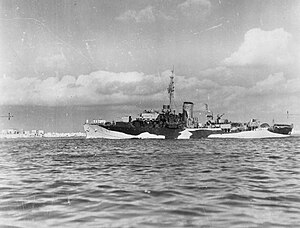HMS Bryony (K192)
 |
|
| History | |
|---|---|
| Name: | HMS Bryony |
| Builder: | Harland and Wolff, Belfast, Northern Ireland |
| Yard number: | 1102 |
| Laid down: | 8 April 1940 |
| Launched: | 16 November 1940 |
| Completed: | 16 June 1942 |
| Commissioned: | 15 March 1941 |
| Out of service: | Sold to the Royal Norwegian Navy in 1948 |
| Identification: | Pennant number: K192 |
| Motto: |
|
|
|
|
| Name: | Polarfront II |
| Acquired: | 1948 |
| Struck: | 1979 |
| General characteristics | |
| Class and type: | Flower-class corvette |
| Displacement: | 940 tons |
| Length: | 205 ft (62 m) |
| Beam: | 33 ft (10 m) |
| Draught: | 11.5 ft (3.5 m) |
| Propulsion: |
|
| Speed: | 16 knots (30 km/h) at 2,750 hp (2,050 kW) |
| Range: | 3,500 nautical miles at 12 knots (6,500 km at 22 km/h) |
| Complement: | 85 men |
| Armament: |
|
HMS Bryony was a Flower-class corvette that served in the Royal Navy.
She was launched from the yards of Harland and Wolff, Belfast, Northern Ireland on 16 November 1940, having been laid down there on 8 April of that year. During her construction, an air raid on Belfast had damaged Harland and Wolff's yards, and Bryony was sunk by a direct hit. Her upper deck and superstructure were wrecked, and most of her hull plates were blown off, whilst the remainder of the hull was flooded. She was inspected by officials from Harland and Wolff and the Admiralty, and it was decided that it would be feasible to refloat and rebuild the ship.
These events would give her the longest build time for any of the Flower class. She was built as a short fo'c'sle corvette, but after her salvage she was given a lengthened fo'c'sle and minesweeping gear. Although many Flowers eventually got the lengthened fo'c'sle, Bryony's was much longer than normal and she could be discerned by such. She was finally commissioned into the Royal Navy on 15 March 1941, under Lieutenant Commander Stewart of the Royal Naval Reserve. She left Belfast, crossing the Irish Sea to Tobermory in Scotland to undergo a two-week work and training exercise period, after which she sailed to Gladstone Dock, Liverpool, where she would be based until June 1943. Whilst in her trials period she was assigned to escort Convoy PQ-18, the next attempt to deliver supplies to Russia after the heavy losses sustained amongst Convoy PQ-17.
The convoy had mostly assembled by 1 September 1942 in Loch Ewe, and departed the following day. By 12 September a long-range Focke-Wulf Fw 200 Condor aircraft had detected and begun to shadow the convoy, directing German U-boats to the scene. Eventually seven U-boats were shadowing the convoy; these were for the moment kept at bay by Grumman Avenger anti-submarine aircraft and the escorts. On 14 September, U-457 penetrated the screen and torpedoed the tanker SS Atheltemplar in the engine room. Crippled, the ship was abandoned, as there were no spare ships available to tow her to Spitsbergen.
...
Wikipedia
